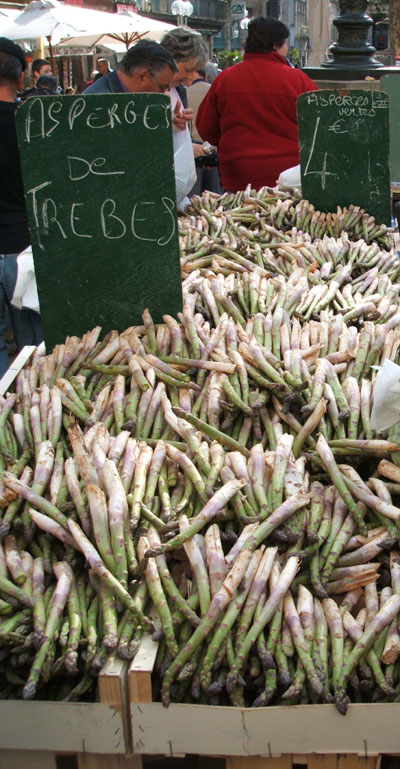Asparagus officinalis is a flowering plant species in the genus Asparagus, a member of the lily family, from which the popular vegetable known as asparagus is obtained. It is native to most of Europe, North Africa and Asia.
Asparagus has been used from very early times as a vegetable and also as a medicine due to its diuretic properties. The rhizomes and root are used to treat urinary infections, as well as kidney and bladder stones and it is said to have aphrodisiac properties. Well, they would say that wouldn’t they!
Only the young shoots of asparagus are eaten. It is a nutrient-rich food which is high in folic acid and is a good source of potassium, fibre, vitamin B6, vitamins A and C, and thiamine. It has no fat and no cholesterol and is low in sodium.
 Once known in Britain as ‘sparrowgrass’ it has been grown in English gardens since the 16th century, and grown commercially since the 17th century. Although it was once grown only in particular areas, such as the Vale of Evesham, East Anglia, Kent and London, asparagus is now grown in most of the UK. It’s no longer considered as posh nosh as it’s now cheaper and more widely available with a longer season than ever before.
Once known in Britain as ‘sparrowgrass’ it has been grown in English gardens since the 16th century, and grown commercially since the 17th century. Although it was once grown only in particular areas, such as the Vale of Evesham, East Anglia, Kent and London, asparagus is now grown in most of the UK. It’s no longer considered as posh nosh as it’s now cheaper and more widely available with a longer season than ever before.
Asparagus spears grow from a crown that is planted about a foot deep in sandy soil. Under ideal conditions an asparagus spear can grow 10″ in a 24-hour period. Each crown will produce spears for up to 7 weeks during the spring and early summer. The temperature determines how often the spears can be picked. At the start of the season there might be 4-5 days between pickings. As the weather gets warmer, a bed might need to be picked every day.
After the harvesting period the remaining spears grow into ferns, which produce red berries and the nutrients necessary for a productive season the following year.
An asparagus planting is usually not harvested for the first 3 years (that’s the reason why most of us buy it rather than grow it!), allowing the crown to develop a strong root system. A well-tended plant will often produce for about 15 years!
Asparagus comes in a variety of colours – green, white, purple – and different sizes ranging from very thin (called sprue) to very thick (jumbo). Nicola Watkins of the Asparagus Growers’ Association advises that the best way to grow your own is to “buy a crown that is already a year old, plant it in April and it will be ready to harvest in the third year.” She says, “The English climate allows asparagus to grow slowly over three years, producing a full flavour and tender texture.”
Some British farmers grow the vegetable under polythene tunnels and harvest from the end of March. The rush to get the first English asparagus into shops has led some commentators to christen English asparagus “the new Beaujolais Nouveau.”
There is a recipe for cooking asparagus in Apicius’ third century “De re Coquinaria.” It was cultivated by the Egyptians, Greeks and Romans, but it fell out of favour in the Middle Ages only to return again in the seventeenth century.
The English prefer the green variety, but on the Continent the white one, grown in the dark, is favoured. In England the belief is that the white asparagus is too mild but the French believe it has a distinct flavour of its own.
Choose spears with tight buds. Buds that have started to open up will be less fresh and will not keep so well. Snap off the hard, fibrous stalk at the bottom, (sometimes throwing away as much as 2/3 of the stem!) stand them with the thick stem down, and steam them for three to seven minutes, depending on their size.
Asparagus goes well with butter, cheese and eggs, marries well with herbs such as tarragon and chervil, and is often served with chicken and white fish. Eat the spears with melted butter, hollandaise sauce or vinaigrette dressing, cook them in risottos and quiches or stir-fry them with red pepper, spring onions and soy sauce.
Asparagus Tart
Enough shortcrust pastry to line an 8-inch flan dish
150 ml double cream
2 eggs
200g Cheddar cheese, grated
200g green or white asparagus
Handful fresh chives, chopped
1 teaspoon mustard, Dijon is a good choice
Pre-heat the oven to 190 C / Gas Mark 5 / 375 F. Roll out the pastry and line an 8-inch flan tin.
Cover pastry with a sheet of grease-proof paper and then fill with baking beads. Bake for 15 minutes.
Wash the asparagus thoroughly and break off the tough end. You might need to peel fatter spears that have fibrous skins
Steam for 5 – 7 minutes and drain.
Beat together the cream and the eggs. Add the herbs, salt and pepper and the mustard.
Add cheese to the cream mixture.
Pour the mixture into the pastry case and arrange the asparagus on top.
Bake for about 35 minutes or until the egg mixture is risen and just set.
This is good either hot or at room temperature.
Article, image and recipe by Chrissie Walker © 2018
